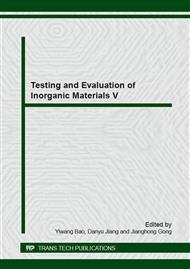[1]
L.X. Li, Y.J. Xie, Z.W. Feng, C.H. Zhu, Cement hydration mechanism and research methods, Concr. J., 6(2011): 76-80.
Google Scholar
[2]
P. Colombet. Nuclear magnetic resonance spectroscopy of cement-based materials. Springer Verlag, 1998, pp.72-152.
Google Scholar
[3]
K. Velez, S. Maximilien, D. Damidot, G. Fantozzi, F. Sorrentino. Determination by nanoindentation of elastic modulus and hardness of pure constituents of Portland cement clinker Cem Concr Res, 31 (2001): 555–561.
DOI: 10.1016/s0008-8846(00)00505-6
Google Scholar
[4]
G. Constantinides, F. Ulm, On the use of nanoindentationfor cementitious materials, Mater Struct, 36 (2003): 191–196.
Google Scholar
[5]
P. Lura, P. Trtik, B. Munch. A critical examination of statistical nanoindentation on model materials and hardened cement pastes based on virtual experiments , Cem Concr Comp, 31(2009): 705–714.
DOI: 10.1016/j.cemconcomp.2009.07.001
Google Scholar
[6]
F.J. Ulm, G. Constantinides. The effect of two types of C–S–H on the elasticity of cement-based materials: Results from nanoindentation and micromechanical modeling, Cem Concr Res, 34(2004): 67–80.
DOI: 10.1016/s0008-8846(03)00230-8
Google Scholar
[7]
J.I. Goldstein, D.E. Newbury, P. Echlin, D.C. Joy, Scanning eletron microscopy and X-ray Microanalysis, third ed, Plenum Press, New York, 2003, pp.33-56.
DOI: 10.1002/sca.4950140611
Google Scholar
[8]
E. Lippmaa,M. Maegi,A. Samoson, etal. Structural studies of silicates by solid-state high-resolution silicon-29 NMR , J. Am. Chem. Soc., 102(1980): 4889-4893.
DOI: 10.1021/ja00535a008
Google Scholar
[9]
M. Magi, E. Lippmaa, A. Samoson, G. Engelhardt, Solid-state high-resolution Si-29 chemical shifts in silicates, J. Am. Chem. Soc., 88(1984): 1500-1581.
DOI: 10.1021/j150652a015
Google Scholar
[10]
E. Lippmaa, M. Magi,M. Mark, W. Wieker, A high resoulation Si-29 NMR study of the hydration of tricalcium silicate, Cem Concr Res, 12(1982): 597-602.
Google Scholar
[11]
J.R. Barnes, A.D.H. Clague, N.J. Clayden, C.M. Dobson, C.J. Hayes, G.W. Groves, S.A. Rodger, J. Mater. Sci. Lett. 4 (1985): 1293.
Google Scholar
[12]
F. Sorrentino, K. Velez, S. Maximilien, et al. Determination by nanoindentation of elastic modulus and hardness of pure constituents of Portland cement clinker , Cem Concr Res, 2001, 31(4): 555–561.
DOI: 10.1016/s0008-8846(00)00505-6
Google Scholar
[13]
P. Acker, Swelling, shrinkage and creep: a mechanical approach to cement hydration, Mater Struct, 268(2004): 237–243.
DOI: 10.1617/14161
Google Scholar
[14]
E. Gallucci, P. Mathur, K. Scrivener, Microstructural development of early age hydration shells around cement grains, Cem Concr Res, 40(2010): 4-13.
DOI: 10.1016/j.cemconres.2009.09.015
Google Scholar
[15]
S. Han, P.Y. Yu, Study on the hydration product of cement in early age using TEM, Sci China Tech Sci, 55(2012): 2284-2290.
DOI: 10.1007/s11431-012-4860-3
Google Scholar
[16]
P.M. Wang, S.X. Feng, X.P. Liu, Application of backscattered electron imaging and image analysis in microstructure research on cement-based materials, J. Eur. Ceram. Soc, 39(2011): 1559-1664.
Google Scholar
[17]
I.G. Richardson, The nature of the hydration products in hardened cement pastes, Cem Concr Comp, 22(2000): 97–113.
DOI: 10.1016/s0958-9465(99)00036-0
Google Scholar
[18]
K.L. Scrivener, The development of microstructure during the hydration of Portland cement, PhD thesis, University of London, (1984).
Google Scholar
[19]
K.L. Scrivener, Microstructure of concrete, in: J. Skalny (Ed. ), Materials Science of Concrete I, Westerville, Ohio, 1989, p.127–162.
Google Scholar
[20]
P. Lura , P. Trtik Validity of recent approaches for statistical nanoindentation of cement pastes, Cem Concr Comp, 33(2011): 457-465.
DOI: 10.1016/j.cemconcomp.2011.01.006
Google Scholar


